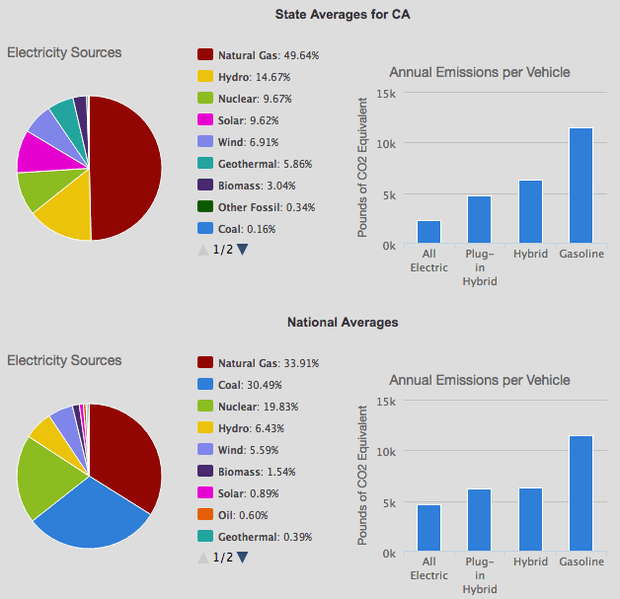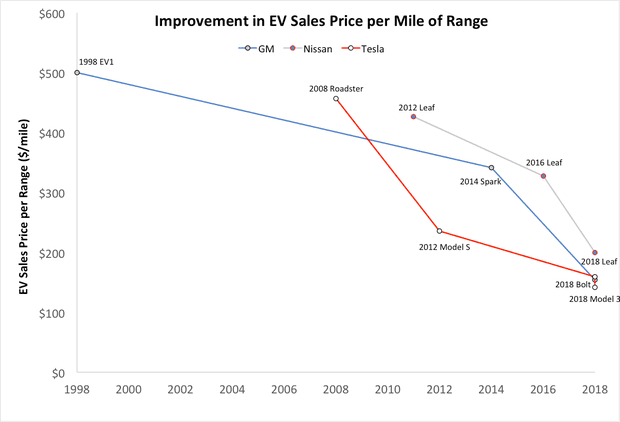Switching to electric cars is key to fixing America's 'critically insufficient' climate policies
Posted on 22 January 2018 by dana1981
In order to meet its share of the carbon pollution cuts needed to achieve the 2°C Paris international climate target, America’s policies are rated as “critically insufficient” by the Climate Action Tracker. The Trump Administration has taken every possible step to undo the Obama Administration’s climate policies, including announcing that America will be the only world country to withdraw from the Paris agreement, and trying to repeal the Clean Power Plan.
In 2020, the next American president will have to make up the lost ground and come up with a plan to rapidly accelerate the country’s transition away from fossil fuels. Currently, transportation and power generation each account for about 30% of US greenhouse gas emissions, so those sectors represent the prime targets for pollution cuts.
Carbon pollution from electricity is already falling fast
American power sector carbon emissions had exceeded those from transportation from 1979 until 2016. But because coal power plants have rapidly been replaced by natural gas and renewables, US power sector emissions have fallen rapidly since 2007, and are now below 1989 levels. US carbon pollution from transportation, on the other hand, has been on the rise since 2012. It remains higher than in 2000, nearly 20% higher than 1989 levels, and has surpassed power sector emissions.

US Energy Information Administration data on carbon pollution from the transportation and power sectors since 1973 (2017 estimated from the first 9 months of data) Illustration: Dana Nuccitelli
The transportation sector thus represents a prime target for cutting American carbon pollution, with light-duty (passenger) vehicles accounting for 60% of those emissions and medium- and heavy-duty trucks accounting for a further 23%. These emissions can be significantly reduced by transitioning from the internal combustion engine to electric vehicles (EVs).
Clean energy also makes EVs cleaner
Comparing carbon pollution between gasoline- and diesel-powered cars to those of electric vehicles can be tricky, because it depends on the source of the electricity generation, which varies from place to place. However, based on the average US power grid mix, the Department of Energy estimates that EV carbon pollution is 60% lower than that of gasoline-powered cars. In a clean energy state like California, it’s 80% lower. And even in a state like Wyoming, which gets 96% of its electricity from coal, EV carbon emissions are still 17% lower than gasoline-powered cars (although they’re 50% higher than hybrids).

Emissions for different types of passenger vehicles based on electricity sources in California (top) and the US national average (bottom) Illustration: US Department of Energy Alternative Fuels Data Center
Moreover, EV carbon emissions will only decline as clean energy continues to expand due to its aforementioned rapidly-falling costs and widespread adoption. At some point, the US will inevitably implement climate legislation that includes a price on carbon pollution, which will accelerate clean energy deployment faster yet.
Battery technology is also advancing rapidly
Cost and battery range have been the two barriers to widespread EV adoption. However, both have rapidly improved over the past several years. In 1996, the GM EV1 was the first modern mass-produced EV. It had a range of approximately 100 miles (160 km) per charge at an estimated price of $34,000 ($50,000 in 2016 dollars), which amounts to $500 per mile of range. Tesla produced its first car – the Roadster – starting in 2008, with a range of 244 miles (393 km) at a price of around $100,000 ($410 per mile). Nissan first sold its electric Leaf in 2011 for $33,600 with an 84-mile (135 km) range ($400 per mile).
All three companies have since dramatically improved their EV prices per mile of range. The 2018 Nissan Leaf sells for $30,000 with a 150-mile (240 km) range ($200 per mile). The Tesla Model 3 will sell for $35,000 with a 220-mile (354 km) range or $44,000 with a 310-mile (500 km) range ($140–160 per mile). The Chevy Bolt sells for $36,620 with a 238-mile (383 km) range ($154 per mile).

Sales price per mile of range for key EVs introduced by GM, Tesla, and Nissan. Illustration: Dana Nuccitelli
The price per mile of range has fallen by about 60% in less than a decade, excluding tax credits (which survived the recent tax bill) and additional state incentives that make EVs more affordable to consumers. Crucially, with the introduction of the Chevy Bolt and Tesla Model 3, ranges of reasonably affordable EVs have more than doubled over the past few years. These trends will continue – carmakers have invested $90 billion in batteries and EVs, and most of the major auto companies plan to roll out numerous new EV and hybrid models over the next few years.































 Arguments
Arguments






























State and federal incentives for buying electric vehicles in America:
pluginamerica.org/why-go-plug-in/state-federal-incentives/
www.usatoday.com/story/money/cars/2017/12/19/electric-car-buyers-still-get-incentives-under-tax-bill/964543001/
Key point. Federal income tax credit of $7,500, and various different state incentives.
What we are now seeing is market convergence of decarbonised electricity generation and most forms of transport because of advances in technology which increasingly make use of fossil fuels more expensive. Let there be no doubt about it – those who have invested in fossil fuel industries will fight a rear-guard action in a vain attempt to prevent or slow this transition.
They will fail because two developments in electricity generation are occurring and gaining momentum:
Firstly: The storage capacity of batteries is increasing and their cost is reducing which, combined with the development of pumped hydro, enables solar and wind generation to become dispatchable 24/7.
Secondly: Batteries with capacity to store all the energy needed by an average household will become increasingly affordable and, in combination with roof-mounted solar panels, will enable many homes to go off-grid, reducing demand from grid-generators.
The move to wind and solar generation is increasing and displacing fossil fuels by (a) generating at less cost than fossil fuels and (b) increasing use of electricity by making it available to those who do not have access to it – without the need for costly, unaffordable infrastructure. Solar and wind generation are already available at lower capital and operating costs than is fossil fuel generation.
It is likely that within the next 2-5 years battery technology will have reduced the price of batteries to less than $100/kWh, making the capital cost of electric vehicles less than vehicles powered by the internal combustion engine. As soon as this is achieved, producers will cease manufacturing fossil-fuelled vehicles (which will become unsellable) and consumers will only ‘buy electric’.
These transitions to solar/wind generation and electrification of transport could be complete as soon as 2040, even earlier!
Tony Seba video on the electric vehicle disruption, and end of oil by 2030.
www.youtube.com/watch?v=E7Jg1IJ68_g
This is Tony Seba's Clean Disruption Keynote presentation at the Swedbank Nordic Energy Summit in Oslo, Norway, March 17th, 2016.
Looking at that first graph anticipates hope!
Electric trucks will be the leap but when autonomous vehicles get the go ahead I think the car will largely disappear as it represents personal freedom and autonomous cars take that away ...
...just to think: the 21st century was started with 4 jet liners and now we‘re looking envisioning crazy stuff like 150 passenger electric planes! Why???
bozzza@4,
The perception of what owning a car was all about definitely will change.
Car ownership always was an significant expense for the average person.
Any place on the planet that was developed based on the 'need to have a car' will be at a significant economic competitive disadvantage in the future.
Automated cars will very efficiently travel through level crossings. Freeways through developed areas are wastes of land that increase travel distances and the elevated portions are expensive to maintain.
However, the future disadvantage of developing down unsustainable paths is 'someone else's problem' which is the poor excuse behind most unsustainable and damaging Private Interest pursuits of personal benefit.